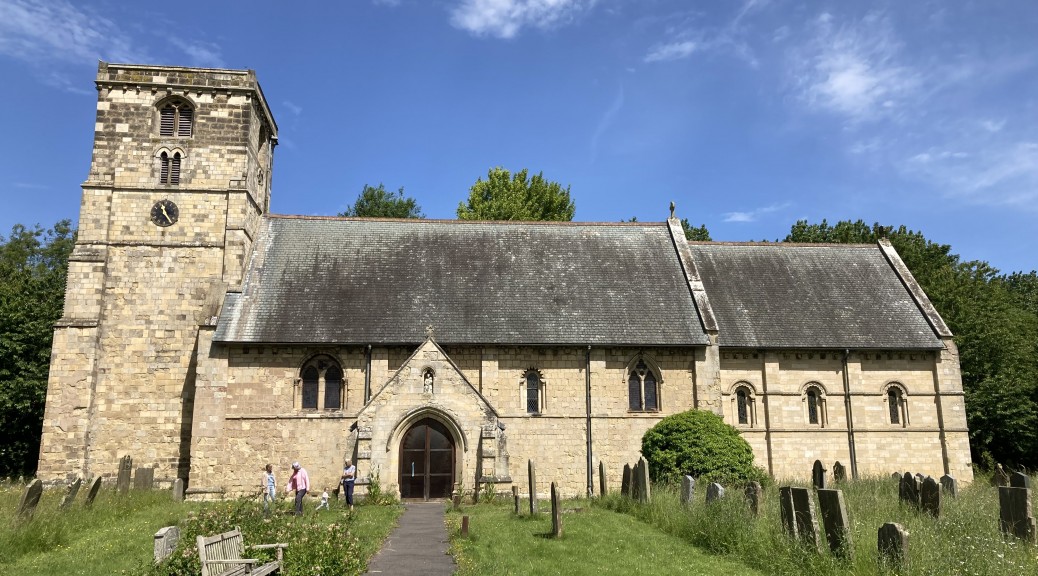Visitors to the high wolds – the countryside around Sledmere on the Yorkshire Wolds – can’t fail to notice the links to the Sykes family. The impressive Sledmere House, the memorials and the Sykes estate properties with their distinctive red paintwork are very visible reminders of the family’s association with the area. However, almost entirely hidden behind a stand of trees is another remarkable feature: St Mary’s church. Built between 1893 and 1898 at a cost of at least £60,000 – equivalent to more than five million pounds today – it is the grandest place of worship on the Sykes Churches Trail.
From a display board in St Mary, Sledmere:
Between 1856 and 1913 Sir Tatton Sykes, 4th baronet (1772-1863) and Sir Tatton Sykes, 5th baronet (1826-1913) of Sledmere built, rebuilt or restored 18 rural churches in East Yorkshire, chiefly on the Wolds. It was the aim of Sir Tatton Sykes II, ‘perhaps the greatest English church builder of the 19th century’, to create centres of ‘Christian Art and Worship’ and he spent a fortune to produce some of the finest village churches in Britain. Three of the greatest Gothic Revival architects were employed: John L. Pearson, later architect of Truro Cathedral, George Edmund Street, best known for the Royal Courts of Justice, Strand, and Temple L. Moore, whose career began in the East Riding.
The glory of the impressive architecture of the Sykes churches is equalled by the splendour of their Victorian and Edwardian furnishings by leading craftsmen and artists of the age. On sunny days the churches are flooded with colour from stained glass by the firms of Clayton & Bell, Burlison & Grylls, Kempe & Co., and H.V. Milner. The roofs are painted, the floors covered with decorative tiles, and the ornate wooden or wrought iron and brass screens divide nave from chancel.
The Sykes Churches Trail appears to have come about in 2013 to mark the hundredth anniversary of the death of Tatton Sykes II. It is separated in to a southern circuit and a smaller northern circuit, with Sledmere appearing on both. Over the summer of 2022 I completed several shorter rides in order to devise a single manageable, but challenging, Sykes Churches Trail suitable for road and touring cyclists. It covers a little over 100 miles.
Not all of the Sykes churches are included in the resultant route. I originally visited North Frodingham and Wansford but discounted them as, well, this is a web site celebrating cycling on the Yorkshire Wolds and these two villages are on the Holderness plain. (Similarly, the church of St Margaret, Hilston sits on the North Sea coast and was in any case destroyed by a bomb and rebuilt in the 1950s.) St Peter, Langtoft and St Andrew, East Heslerton failed to make the cut because of their proximity to unsuitable main roads. None of these roads is free from risk but, ultimately, safety won out over completeness.
This, entirely unofficial, cyclist-friendly Sykes Churches Trail incorporates both northern and southern circuits and fourteen of the Sykes churches. A photograph and description of each church is given below. The cyclist’s cardinal sin of going back over the same roads is kept to a minimum, and is limited to the final spur at Bishop Wilton (a place that would make for an interesting start point). A desire to avoid uphill sections on the busier roads, and to miss out less scenic views, led to some slightly extended loops and route-making decisions. (For instance, as a risk averse cyclist I never ride uphill from Fimber to Sledmere, or from Sledmere to the Cowlam crossroads, and I avoid the featureless drag from Wetwang to Huggate.) Ultimately, the choice of route – and the decision to drop some Sykes churches from the list – was determined by a mixture of safety concerns, a need for quiet roads and a wish to take in the varied and pleasant scenery of the Yorkshire Wolds.
A suggested cyclist’s route for the Yorkshire Wolds Sykes Church Trail as a Garmin Connect course. (Note that East Heslerton and Langtoft are omitted because of their proximity to unsuitable roads.)
You can also view the Sykes Churches Trail – A Cyclist’s Route as a Strava segment and as a Garmin Connect activity.
Sykes Churches Trail – A Cyclist’s Route
As already mentioned, this route could be started at other points – including Hutton Cranswick or Driffield if arriving by train – but here the start point is Field House Farm Campsite, Tibthorpe, which is an excellent base for day rides on the Yorkshire Wolds. (Several other varied route suggestions can be found on the campsite’s listing as one of the ‘Ride Base Loops‘ on this web site.) Consequently, approximate mileage figures for each of the villages passed through are taken from Field House Farm; the route does not necessarily pass immediately by each of the churches and a very short detour may be required to visit some of them. Descriptions of each church are reproduced from material written to promote the trail in 2013.

St Mary, Kirkburn (mile 3). “An early 12th century Norman church restored by J.L. Pearson for Sir Tatton Sykes I in 1856-7 when the south porch was added. The spectacular Norman doorway of three orders has beakhead and zigzag in the arch and a hoodmould with beasts and figures. Inside there is a fine Norman chancel arch and a delightfully rustic font carved with figures including what appears to be a cat with a mouse. Street furnished the chancel in 1872 and designed the ornate reredos carved by Redfern.”

St Michael, Garton-on-the-Wolds (mile 6). “An imposing Norman church dating from around 1120. It was restored by J.L. Pearson for Tatton Sykes I in 1856-7 when he reconstructed the Norman south doorway and the chancel. The interior comes as a great surprise. In 1872 Tatton Sykes II employed G.E. Street to furnish the church and he was responsible for the extraordinary paintings which cover the walls of the nave and chancel and the jewel-like stained glass. The paintings and glass are by Clayton & Bell and show related Old and New Testament scenes.”

St Mary, Sledmere (mile 11). “The grandest of the Sykes churches built for Tatton Sykes II in 1893-8 at a cost of at least £60,000. Designed by Temple Moor it stands on the site of a 14th-century church that was rebuilt, except for the tower, in 1758. The church is a most lavish essay in the Decorated style with a richly carved red sandstone interior, particularly in the chancel. There is an ornate screen and rood loft and elaborate reredos. The stained glass is by H.V. Milner and Burlison & Grylls (north aisle). There are monuments to the Sykes family from the former church and the fascinating illuminated book commemorating the Wagoners Reserve of the First World War.”
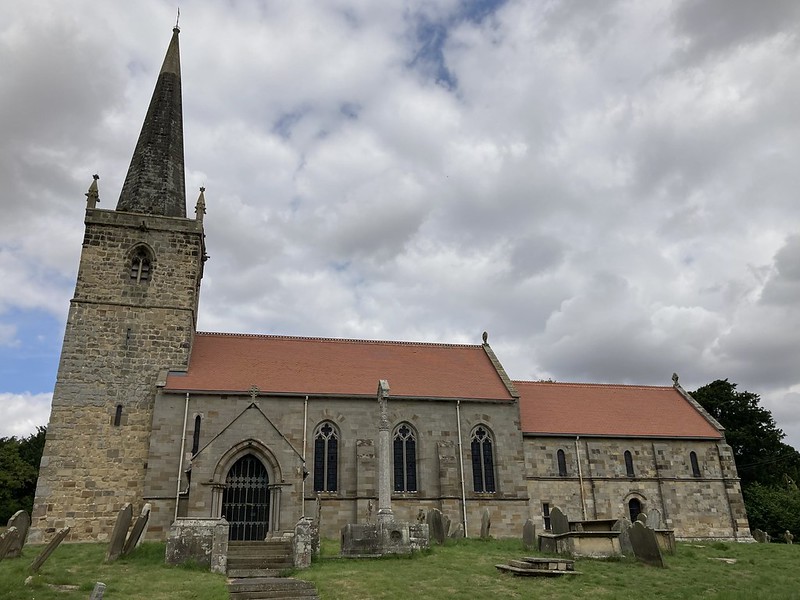
St Andrew, Kirby Grindaltythe (mile 14) “The church with its prominent spire is well sited in a large churchyard on the side of the valley above the Gypsey Race. Dating from the early 12th century the church has earlier origins revealed by fragments of 9th-11th century crosses and an early Romanesque tomb chest. The chancel was reconstructed and a new nave built in 1872-5 by G.E. Street for Sir Tatton Sykes II who provided it with stained glass by Clayton & Bell and H.V. Milner, pretty wrought-iron and wooden screens and a carved alabaster and marble reredos, and covered the whole of the west wall of the nave with a startling mosaic by the Venice and Murano Glass & Mosaic Co. depicting the Ascension.”

St Mary, West Lutton (mile 16). “St Mary’s is one of the most delightful of the smaller Sykes churches with its pretty wooden bell turret in Home Counties style and great variety in window pattern. Designed by G.E. Street and built in 1872-3 it cost Sir Tatton Sykes over £13,000. The church has a sumptuously decorated interior. The roof, of the nave, aisles and tunnel-vaulted vestry, is painted all over with floral designs and texts and has stars and suns in relief. The raised chancel is stone-vaulted with a painted reredos by Burlison & Grylls who were also responsible for the stained glass installed throughout the church in 1891.”
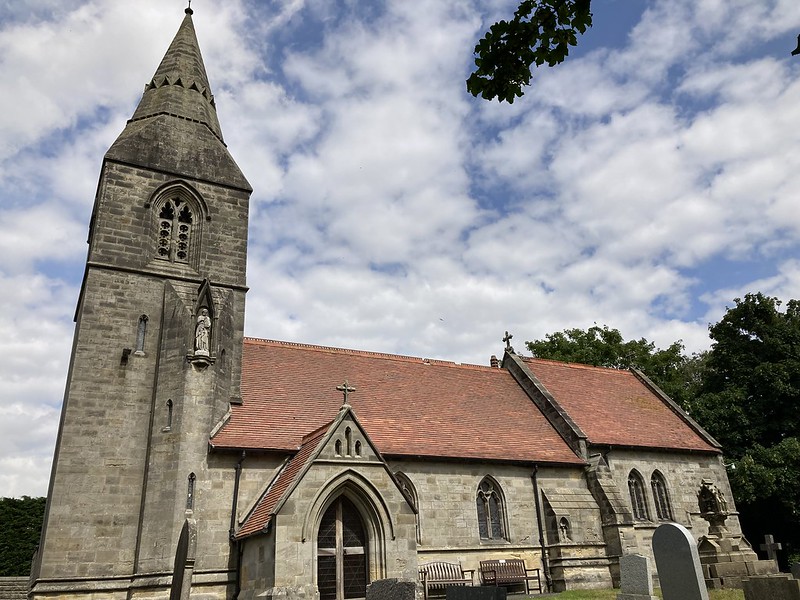
St Peter, Helperthorpe (mile 17). “Standing to the north of the village street St Peter’s is another church designed by G.E. Street for Sir Tatton Sykes II, again entirely individual. Built 1871-3 in the Early Decorated style it has a distinctive tower with bold spire and canted stair turret. Externally the chancel is a little higher than the nave, internally it has eight steps above. Inside the richly painted roofs of the nave, with bands of flowers and stars in relief, and the chancel, with floral panels, are the most striking features. The stained glass by Burlison & Grylls replaced the original scheme by Clayton & Bell in 1893, when the north aisle was added by Temple Moore who designed the fine stone reredos there. The Old Vicarage is by Street.”
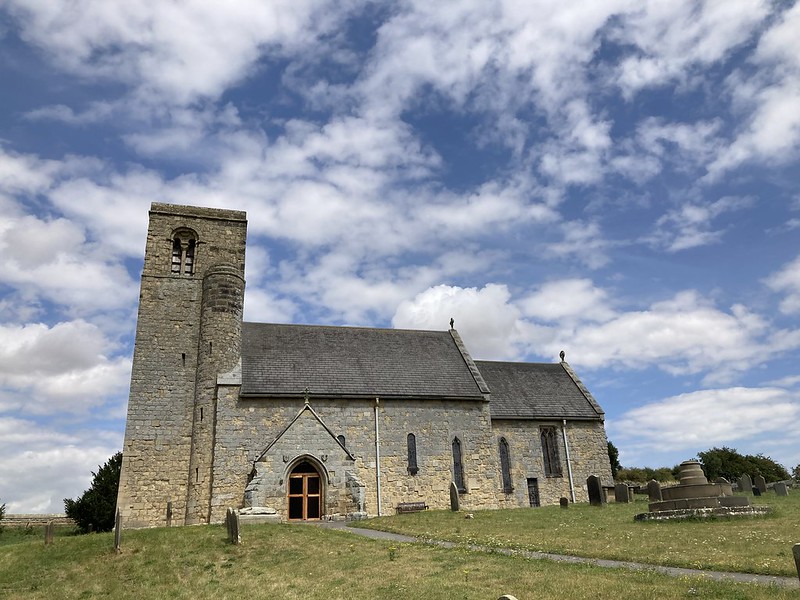
St Andrew, Weaverthorpe (mile 18). “High up above the village, alongside the earthworks of a medieval manor house, stands this superb Norman church, restored by G.E. Street for Sir Tatton Sykes II in 1870-2. The inscription on the sundial over the entrance records that the church was built by Herbert of Winchester, the father of St William of York, probably c. 1120. The tall slim early Norman tower has a rounded staircase turret. Inside the high plain stone walls of the narrow aisleless nave contrast with the decorated barrel-vaulted roofs and the lavish Victorian furnishings. The stained glass is by Clayton & Bell.”
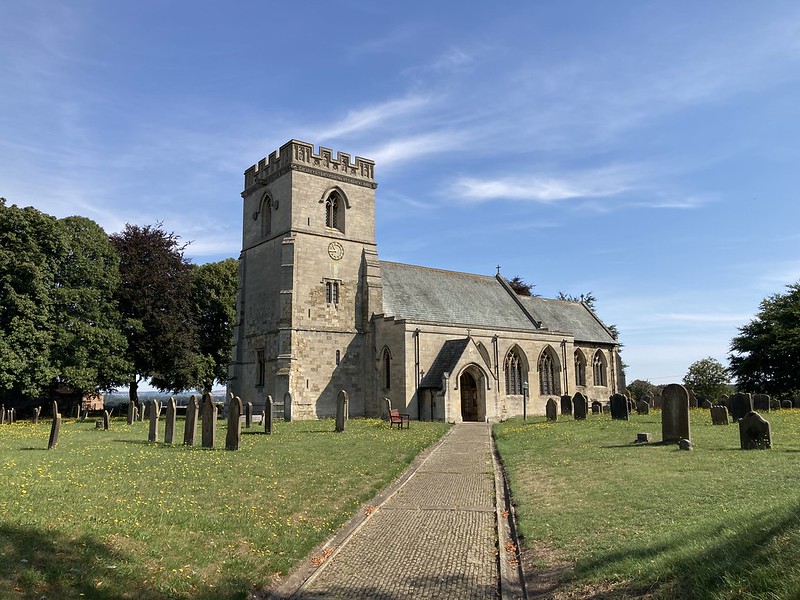
St Hilda, Sherburn (mile 25). “At the north end of the village in a large churchyard St Hilda’s, the last of the churches funded by Sir Tatton Sykes II, was completed just before his death. Largely rebuilt by C. Hodgson Fowler 1909-12, the earliest features in the church are the nine pieces of Anglo-Saxon sculpture at the base of the tower, and the wide Norman chancel arch. The interior has exceptional early 20th-century woodwork by Thompson & Co. including a richly carved rood screen, choir stalls with carvings of animals and birds, the organ case and font cover, and the chancel roof with winged angels. Unusually for a Sykes church the only stained glass is medieval fragments in the west window of the south aisle.”
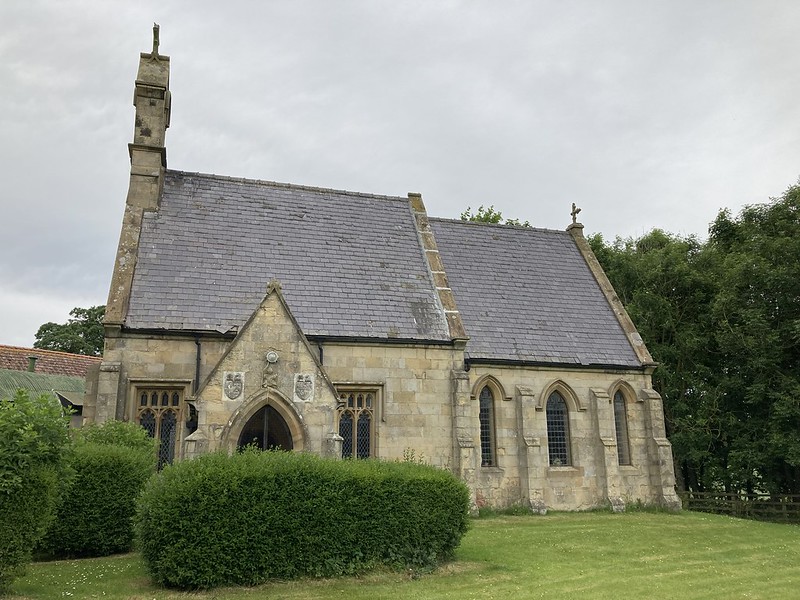
St Mary, Cowlam (mile 41). “A small medieval church that was restored and partly rebuilt in 1852 to designs supplied by Mary E. Sykes, daughter of Tatton Sykes I. The village was depopulated in the late 17th century and the church is reached through a farmyard. Inside is a tub-shaped Norman font richly carved with figures including the three Magi, Adam and Eve, and two wrestlers.”
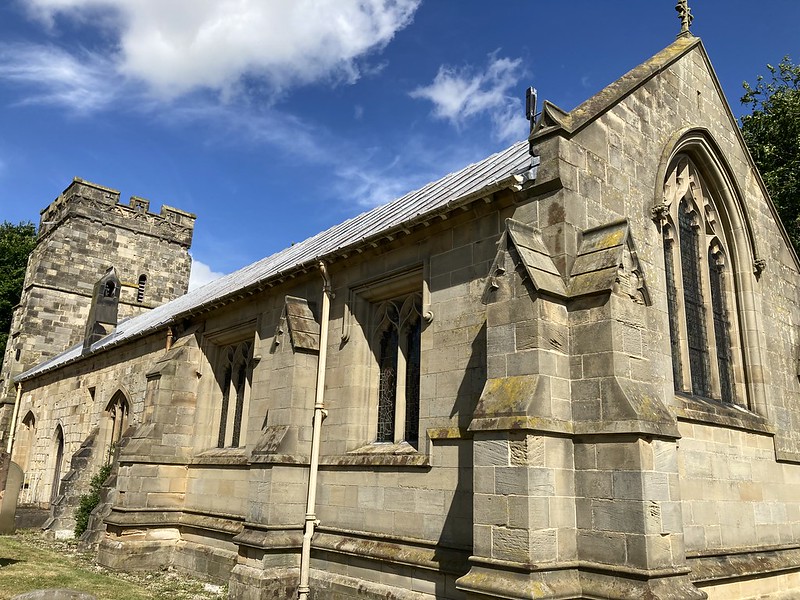
St Nicholas, Wetwang (mile 70). “The fascinating history of the development of this church from the 11th to the 20th century can be traced in the stonework and fittings. From the Norman period are the north arcade, two windows in the nave, the font and reused carvings in the vestry and under the tower. The tower and north chapel are 13th century, the north doorway is 14th century. There are remnants of 17th-century texts on the nave wall. There was a restoration in 1845-6 paid for by Tatton Sykes I but his son financed a more comprehensive programme of works by Temple Moore in 1895-6 on the tower and north wall, and C. Hodgson Fowler who rebuilt the chancel and re-roofed the nave in 1901-2 when the stained glass by Burlison & Grylls was inserted.”
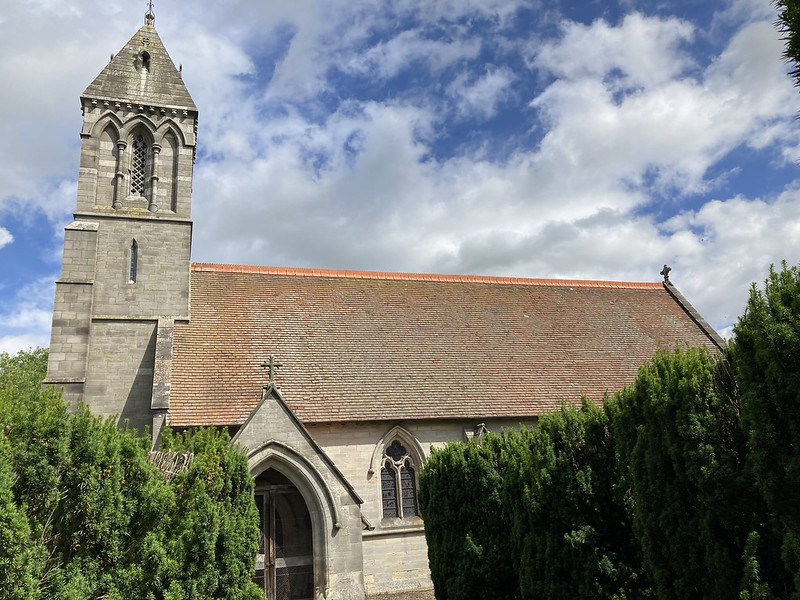
St Mary, Fimber (mile 76). “The church, of Whitby stone in a 13th-century style, was designed by G.E. Street and built 1869-71 for Tatton Sykes II. It replaced a small chapel-of-ease that had been built on the site of a Bronze Age burial mound. The chancel has an ornate brass and iron screen and a richly carved reredos. The fine stained glass windows are by Clayton & Bell.”
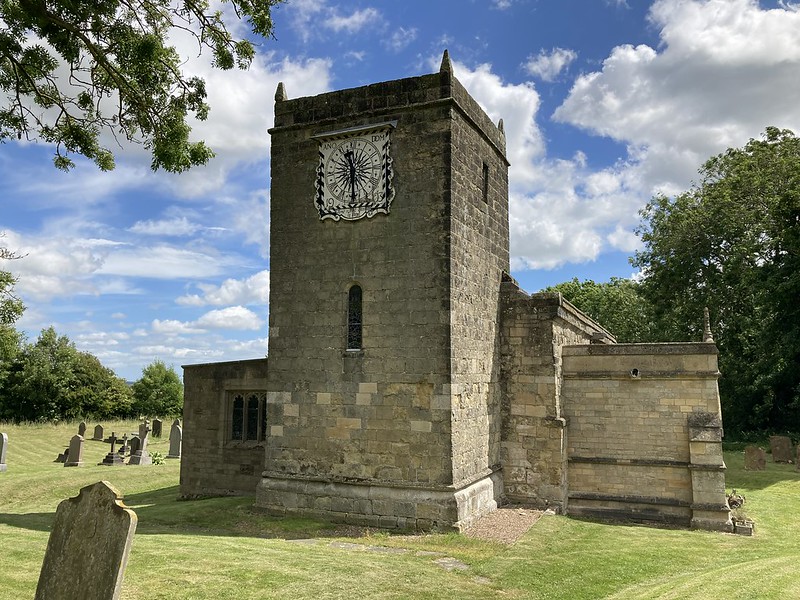
St Mary, Fridaythorpe (mile 78). “Another interesting church restored for Tatton Sykes II by C. Hodgson Fowler in 1902-3. He added a new north aisle, replacing a 13th-century aisle long demolished, and the south porch to what is largely an early 12th-century building. The squat tower has an elaborate Edwardian clock face. There is a curious inscription ‘this 713 found hear’ carved on the capital of the first column from the east in the north arcade. The ornate carved reredos came from Sledmere church and the glass is by Burlison & Grylls, 1910.”

St Mary, Thixendale (mile 81). “The church, built 1868-70, the former vicarage and school (now village hall) and school house form an important group of buildings all designed by G.E. Street for Tatton Sykes II. It is a small church in the style of the 13th century with an aisled nave, bellcote and chancel. The stained glass windows are by Clayton & Bell except the east window by Burlison & Grylls in 1893.”
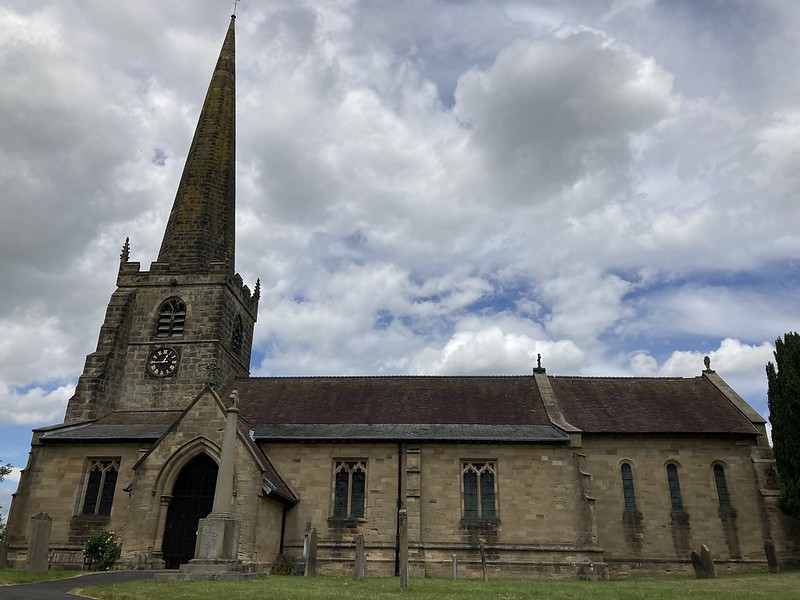
St Edith, Bishop Wilton (mile 92). “As lavish and embellished on the inside as it is visually striking on the outside, with its 15th-century tower and spire, St Edith’s church is a treat. The Norman chancel arch and south doorway are richly carved, the latter with animals, faces and human figures. The church was faithfully restored for Tatton Sykes in 1858-9 by J.L. Pearson who was responsible for the prettily painted hammerbeam roof, possibly the work of Clayton & Bell who were responsible for the stained glass. Temple Moore designed the elaborate font for Tatton Sykes II and the black and white mosaic floor said to be based on a floor in the Vatican and laid by Salviati in 1902.”
Related route alternatives in Garmin Connect
The full 100-mile route above is perhaps too long to form some sort of pilgrimage by bike – certainly for one day. Each church deserves a lengthier visit than is possible during a ride of fourteen churches in one go. Rather, the route is intended as a themed ride to enjoy the mostly quiet lanes around villages of the Yorkshire Wolds that feature a Sykes church. Alternative options are detailed below that allowed me more time to appreciate a number of the churches in greater detail. These are the routes I took when I was looking to put together the longer ride.
Sykes Churches Trail (Southern Circuit) from near Beverley – 100 miles, 4,200 feet
Next page – Disclaimer, Ride Notes and More on the Sykes Churches

